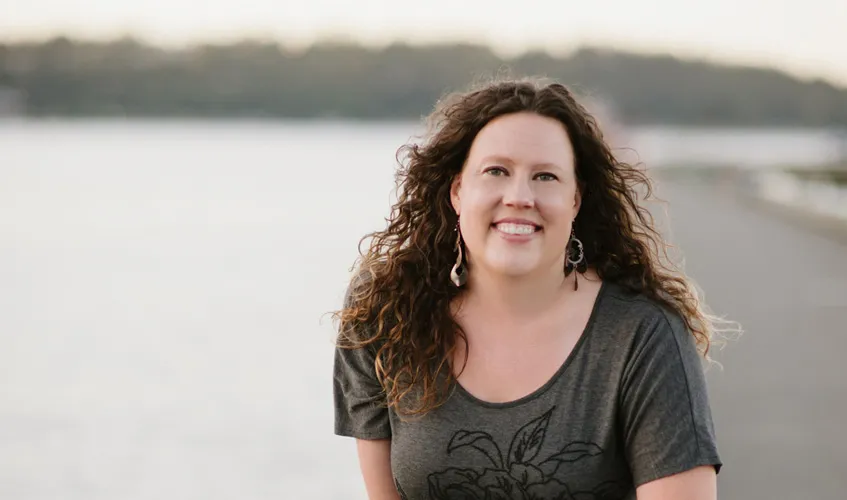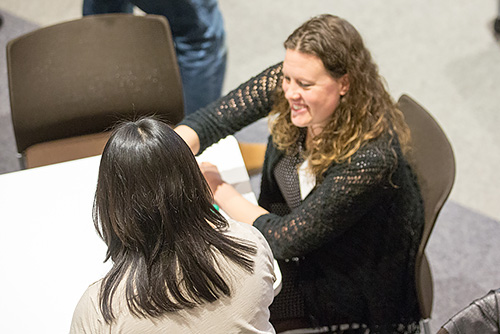Alumna Angela Templin, '99, shares how ME set her up for a successful career in sustainability and commissioning.

Angela Templin, courtesy of Glumac.
Angela Templin, BSME '99, can trace her passion for engineering back to a Valentine’s Day mailbox contest in elementary school. “Most kids decorated old shoe boxes with construction paper, but not me,” she recalls. “I gathered some large sheets of plastic and used them to create a giant, nine-foot tall heart-shaped balloon, which I spray painted red and cut a slot in the side for cards. To keep it inflated, I used the discharge side of my mom’s vacuum cleaner.”
She still remembers the look on her teacher’s face when she wheeled the balloon and vacuum cleaner into class the next day. “It was a look that said, ‘Wow, you win, but you really weren’t supposed to get this into it,’” she laughs. “I couldn’t help it, though, because I loved tackling projects that presented unique opportunities to think outside the box — quite literally in this case.”
That drive served Templin well through college and continues to fuel her today. Now a commissioning lead and project manager for Glumac, a sustainable engineering consulting firm with offices worldwide, she is responsible for ensuring all systems and components of building projects are designed, installed and tested for maximum efficiency, sustainability and safety. Over the years, she has managed many projects, including large-scale infrastructure projects with SeaTac airport and the Alaskan Way viaduct tunnel replacement as well as projects at MoPOP (formerly EMP Museum) and the Seattle Asian Art Museum.
ME’s Chelsea Yates recently talked with Templin about her work and how her time in UW ME helped set her up for success.
Why did you decide to study ME at the UW?
At first I wanted to study medicine, but I can’t stand the sight of blood, so I decided to switch gears. I took ENGR 101 “Engineering Exploration” at the UW just to see what I thought of it. We did a lot of hands-on, team-based, problem-solving activities in that class — one I remember specifically was building a motorized tug-of-war machine — and I loved the challenge of coming up with creative ways to approach the projects and thinking through the mechanics. That’s what led me to ME.
You’ve been working at Glumac since 2011 as a commissioning lead and project manager. What does that entail, and what drew you to the work?
As Glumac’s commissioning lead, I maintain a big-picture understanding of each project my team and I manage and ensure that every operational component of the project is cleared — from specific pieces of equipment to larger, complex systems, such as water and wastewater treatment systems. I work across disciplines to ensure effective communication between designers, engineers and contractors. Not everyone uses the same professional language so I do a lot of translating across teams.
Prior to Glumac, I worked for 15 years as a mechanical engineer at a civil engineering consulting firm, where I’d been a part of several mechanical and electrical engineering projects for public works facilities. We were pretty active in the field during construction, so the move to commissioning was a natural next step for me.
Why is it important to design and construct buildings with sustainability in mind?
Sustainable design increases the efficiency with which buildings use energy and materials. Often sustainable design concepts extend beyond the buildings themselves and include site planning and connection to community infrastructure. Since we live on a planet with limited resources, it’s important to incorporate energy-efficient and sustainable building technologies — radiant heating and cooling, daylight and rainwater harvesting, and renewable energy systems — into our projects. Plus, sustainable buildings are healthier for the people who live and work inside them. They tend to be easier to maintain, and they last longer.
How did your studies in ME help set you up for success in your current role?
My engineering studies provided me core fundamentals in mechanical and electrical engineering, as well as an understanding of thermodynamics and building principles. I also learned to prioritize both efficiency and safety; it’s important not to delay a project, but not to rush it either.
In particular, ME taught me the value of group problem solving; that’s something I use every day at work. My team is often involved in complex projects, and it’s so important that everyone sees themselves as part of the solution and, therefore, is invested in the project’s overall success.
What’s your best memory of being at the UW?
I met my husband, Reid, while I was a UW student. He was majoring in aeronautics and astronautics while I was working on my ME degree. That’s probably the best thing about my time at the UW.
 Templin participates in UW’s Engineering Exploration Night, a program connecting engineering alumni and students to discuss careers and fields.
Templin participates in UW’s Engineering Exploration Night, a program connecting engineering alumni and students to discuss careers and fields.
Over the years, you’ve been involved with several UW engineering programs including Engineering Exploration Night, Math Academy and the ME Leadership Seminar Series. What compels you to stay connected to the UW?
I want to see more women engineers in industry, so if I can help share my expertise and experience in ways that encourage more women to enter the field, I’m eager to do so. Working with engineering access and career exploration programs assists me professionally, too — at Glumac, we’re always looking for fresh talent, so meeting engineering students who will soon be on the job market helps me envision ways we might grow our teams.
I read somewhere that your great-grandfather built escape artist Harry Houdini’s famous underwater cage. Is this true?
Yes! But don’t ask me how he did it — he took those secrets to his grave. One thing that he did pass along, however, was an inclination for the mechanical. I’m pretty sure I inherited some of my interest in mechanical engineering from him.
Meet more ME alums at me.uw.edu/alumni/news
Originally published September 19, 2017